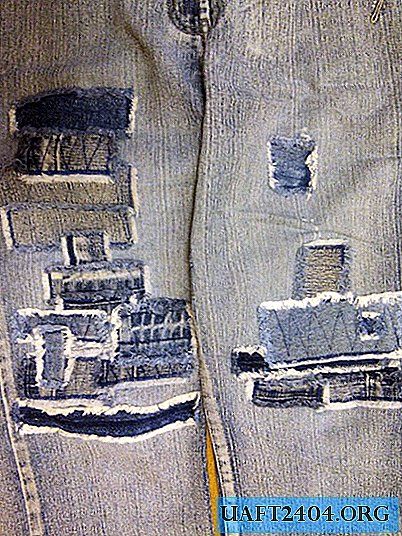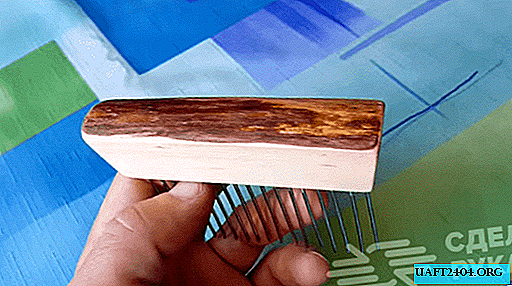Share
Pin
Tweet
Send
Share
Send
On the other hand, for handmade jeans - the material is not the easiest. The fabric is rather heavy and dense, requiring both suitable (preferably special) threads and a reliable sewing machine. Ripping jeans is also “not sugar”: they are, as a rule, stitched tightly and in good conscience - even bite your teeth. While you prepare the fabric for further work, you suffer. Therefore, the most frequent suggestion for remaking is to build a skirt, having sewed an interesting hem and leaving the upper part unchanged (belt, yoke and how much is needed lower). But the fabric is wonderful! Beautiful, strong, erases well and "with age" does not lose effect. And there are many of hers, which turned out to be very important for my idea.

The fact is that we have a dog - a golden retriever of beauty and affection indescribable. And this dog has its own property: rugs and bedding. All this economy should be washed and dried regularly, but it dries poorly and for a long time, because it is thick (multi-layer). Eureka! - you need to build covers, a pair for each rug. From heavy fabric (so as not to fidget) and durable (to last long enough). And jeans for this material is not just suitable, but ideal.

All collected jeans were washed and struts. The ripping process was significantly simplified. Most modern models are scribbled using the "sliding loop" method, and you just need to find the right edge to stretch the entire thread at once. If there is also a stitching, then, of course, in the old fashioned way - scissors, a blade, etc.
For my project, we unzip only the belt, the step seam (zipper, of course, too) and the inner seam. After that, we lay out the resulting halves and carefully look at how the external (side) seam lies on a flat surface. In men's jeans, it is almost flat and does not “excite”. This means that this part can be taken into work without changes. If the jeans were with a complex cut, then the side seams are also unzipped.
Separately solve the issue of riveting. Small and flat can be left, and large and embossed are best removed. The holes from them remain small, almost imperceptible. It is more convenient to remove (bite) more conveniently with side cutters (nippers) or small pliers.
The next stage of preparation is to sew up pockets, i.e. the top of the pocket is simply sewn close to the edge and fasten the ends of the seams. Then we proceed to work with holes and strong scuffs, especially in the knee area. The most reliable way is to apply decorative patches (with or without fringe), and the fastest way is to stitch a pocket in this place. Just cut it close to the seam from the unwanted part of the jeans and sew it over the hole.
It is more convenient to adjust decorative patches with a dense "zigzag" at a distance of 0.5-0.8 cm from the edge, and then make a fringe by pulling out the threads. The form of such patches can be any. Of these, you can even lay out a whole pattern. Another convenience - in the case of a new hole, you can sew the same patch without violating the general style. On my favorite “dog” trousers for walks in the forest, a whole collection of the most “different-jeans” patches has already gathered.
Prepared pieces of jeans can be assembled into a finished thing according to a pattern or "by eye" - depends on the complexity of the cut. A cover for a sofa cushion or for a small mattress is sewn from an assembled rectangular strip. Dimensions are checked during assembly and with allowance for seams. If necessary, zipper is sewn, but it is also possible without a fastener, according to the principle of "envelope" as on traditional pillowcases. Complex cut and large items require more time and effort.


A real test for me was a cover on a street sofa on which my dog spends most of the summer. The frame of the sofa was built from two old chairs from the Soviet era. First they removed all the upholstery from them, then two sidewalls were unscrewed (one of the seats had the right one and the other had the left one). They moved the seats with sides without sides and pulled it with their own bolts through the existing factory holes. A cotton blanket was stuffed with a furniture stapler on the seats and the back. We did not have time to take tools and sweeps to the garage, and the dog was already lying on the new platform. So, I liked the sofa and we must hurry with the cover.
The pattern for the cover was made only on the sides, because the central part is just a very large rectangle. Jeans for everything about everything took six pairs. A very successful detail - belts sewn along the outer contour. It was possible to save on them and stripes, and even buttons, rivets. On one of the sidewalls from the outside, there was an “unworked” open pocket for decoration. The letters along the hem of the sofa are added to my dog's name. They were specially made from different types of fabric in order to preserve the style: all are jeans - and all are different, there is even a check.


The case has been safely living in the yard for a year now. For the winter is not removed, because the sofa is under a canopy, sheltered from rain and snow. Having convinced of its reliability and convenience, I plan to make jeans covers on the pillows of garden furniture. And I will have both a yard and a house - “the jeans of all jeans”!
Share
Pin
Tweet
Send
Share
Send











